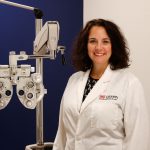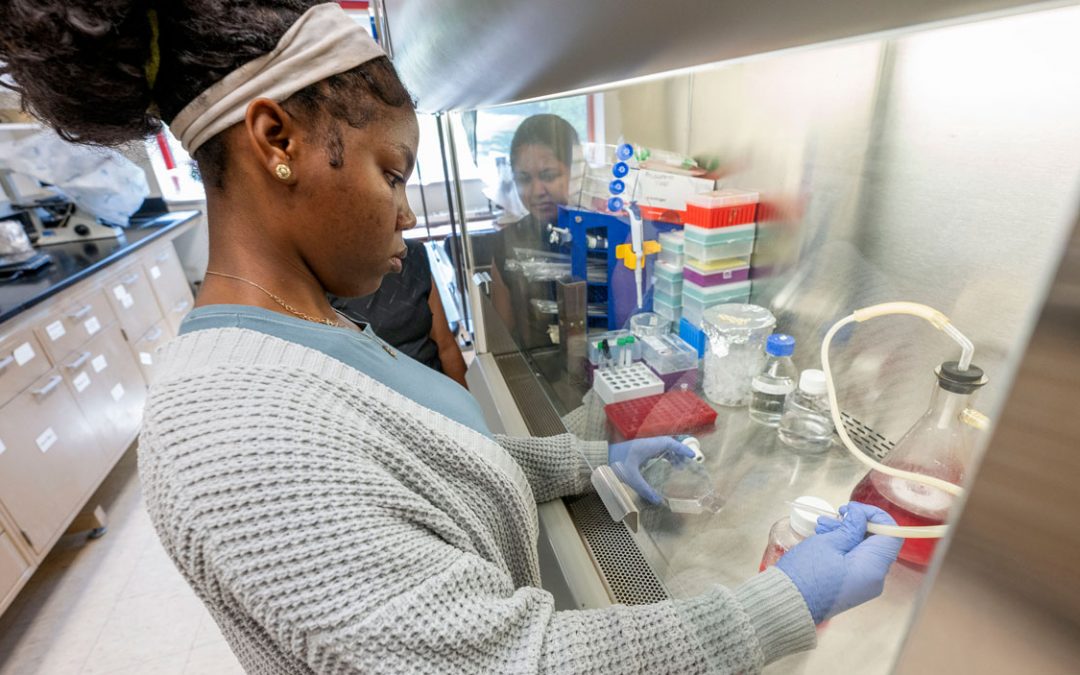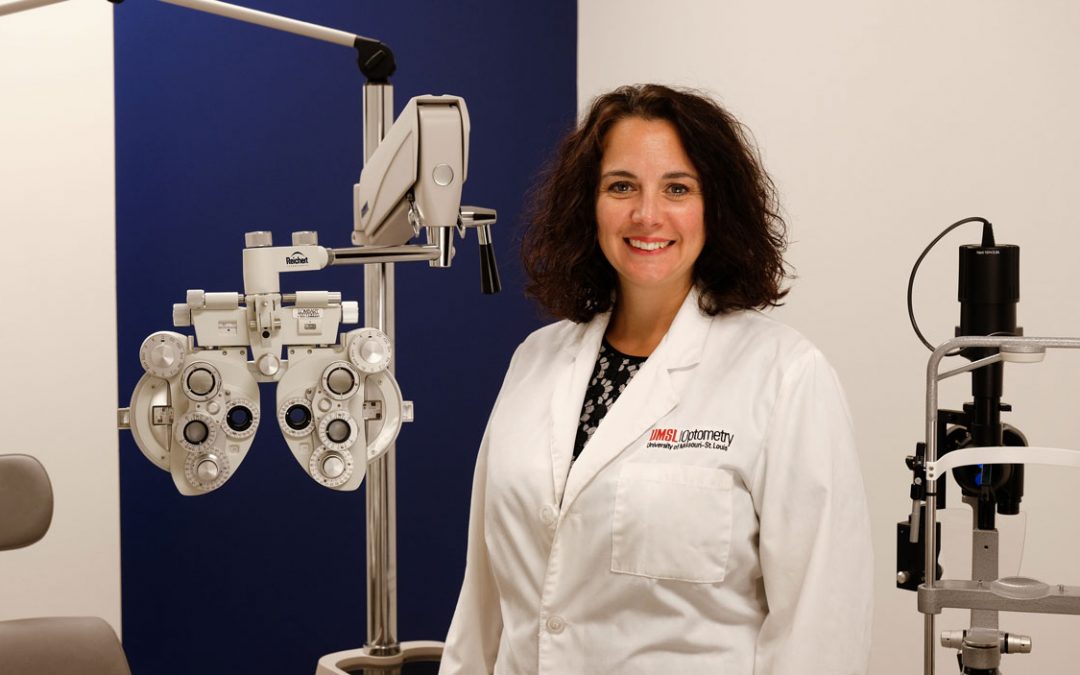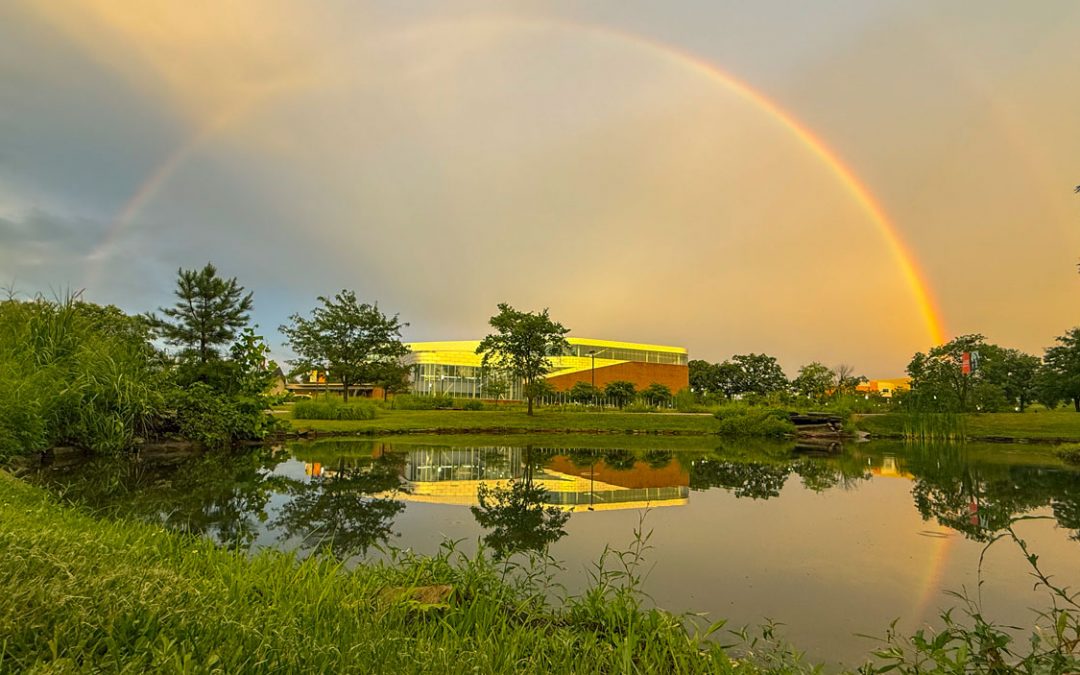
Keeta Holmes (third from right), director of learning innovation and design in the Center for Teaching and Learning, meets with faculty members this week about the Curriculum Alignment Process initiative she is leading with a goal of helping streamline degree pathways and provide students with the clearest path toward graduation with the least debt possible. (Photo by August Jennewein)
If the fundamental purpose of a great university is to educate and graduate diverse students as they seek to improve their lives and realize their dreams, the University of Missouri–St. Louis qualifies as a great university, according to UMSL Provost and Vice Chancellor for Academic Affairs Kristin Sobolik.
“UMSL does an excellent job of providing its students with the knowledge and skillsets essential for success in their chosen fields,” she said. “We are launching the Curriculum Alignment Process to further ensure we are providing our students with the clearest path toward graduation with the least debt possible.”
The Curriculum Alignment Process initiative, Sobolik said, seeks to trim and adjust our curriculum to fit current student needs while also aligning with assessment and learning outcomes, Higher Learning Commission accreditation guidelines and UMSL’s budget realities.
Sobolik said that Keeta Holmes, director of learning innovation and design in the Center for Teaching and Learning, has agreed to lead the project. Holmes, along with Associate Provost for Student Success Beth Eckelkamp, will meet with faculty, department chairs and deans over the next year to develop curriculum recommendations to be implemented by the fall of 2019.
The editors of UMSL Daily reached out to Holmes to discuss what effect this new assignment and project will have on her and the campus.
Tell us about your new/expanded role as director of learning innovation and design for the Center for Teaching and Learning at UMSL.
I am thrilled for this opportunity to think strategically about how students progress through our degree programs. Since 2010, I’ve been working closely with faculty to design meaningful learning experiences in specific courses. My expanded role affords me the chance to think globally about our programs to help program leaders design and clarify student learning paths as students progress through our innovative degree programs.
What exactly does curriculum alignment mean?
Our degree programs offer amazing opportunities to our students. The curriculum alignment process lets us show students how specific courses help them acquire the expertise, skills and knowledge they need to be successful with their particular degree. We often hear students ask, “Why do I need to take XYZ course?” This process helps them understand specifically why a course or an assignment is a critical step in their academic preparation.
What is the goal of the alignment process?
The goal is to create streamlined degree pathways to increase student success rates and meet HLC accreditation criteria as we adopt the UMSL five-year fiscal plan. To meet this goal, we will begin by clarifying each program’s student learning outcomes, then select which courses best prepare the students to show what they know. Along the way, we’ll make choices about how often courses should be offered and what delivery mode serves our students best. Specifically, we’ll determine which courses or programs should be offered in-person, online, or blended; we’ll also find ways to offer new formats for busy adults by offering some courses in shorter terms.
Why is UMSL streamlining its academic offerings? Will this process eliminate course offerings?
Departments regularly think strategically about which courses should be placed and staffed on the schedule to meet demand. Removing course offerings from the schedule isn’t a new idea. Unfortunately, the Bulletin may present a different picture that students have more choices than are actually scheduled. This process is designed to provide students more assurance that courses listed in the Bulletin will definitely be taught. The curriculum alignment process will simply give students a more accurate and simpler picture about the courses they need to take to complete their degrees. Some students report confusion about what they need to fulfill various requirements, and that results in students taking courses they don’t need. That’s something we’re working to eliminate.
How many courses/sections does UMSL annually offer now?
In fall 2016, UMSL offered 4,104 sections (2,550 UG; 1,465 Grad; 89 Professional). In fall 2017, we offered 4,001 sections (2,526 UG; 1,386 Grad; 89 Professional).
Is there a set number of courses/sections UMSL is trying to achieve?
No, there isn’t a set number of courses or sections to reduce. We’re asking each department to be thoughtful about what students need to meet the program outcomes and trim what doesn’t contribute to that. Some departments may not have to cut a single course; other departments may find they have several courses that don’t contribute to the outcomes.
How does a program define learning outcomes?
Faculty define program outcomes in terms of the specific skills, knowledge and expertise we expect a student to acquire as part of their educational experience in the program. To do this, it is helpful to think about what an ideal graduate can do upon graduation. Departments already have a great sense of this, and our campus is very proud of the excellent experience that students have in our programs. It is imperative that we focus on continuous improvement and the opportunity to review and revise outcomes informed by what we hear from UMSL alumni and the community who hire our graduates.
Will students have a role in the alignment process?
Student success is the No. 1 driver of this initiative. Students will have a clearer path to degree completion, more opportunities to take required courses and less debt upon graduation. This process is informed by student-driven data such as course enrollments, student needs and feedback from students via advisors and faculty.
Will deans, department chairs and individual faculty members have input in determining course/section offerings?
Absolutely, they are central to this process. This process requires active input from the faculty, department chairs and deans. My role is to give the departments a framework to follow and the data they need to make the decisions that affect their programs.
What will the final review/approval process look like?
Beth Eckelkamp and I will be actively working with each department to help them align their curriculum with the needs of our students foremost on our mind. An important part of that process will be to invite input from the provost and deans on the decisions made by the departments. As with any curriculum proposals, the Curriculum & Instruction committee of each college, as well as the Faculty Senate, must approve any changes to degree programs. The curriculum proposal process is slated to be complete by the spring of 2019.
With many university initiatives underway, why is now the right time to focus on curriculum alignment?
There certainly are many initiatives underway here at UMSL, and I believe now, more than ever, it is important to shine a light on why we do what we do. As the campus refines our strategic plan, reviews recommendations about academic prioritization, prepares for a visit from HLC accreditation committee and searches for ways to cut operational and student incurred costs, our faculty will reflect critically on how our course offerings can be streamlined so students finish their degrees in a timely way without paying for excess credits.














